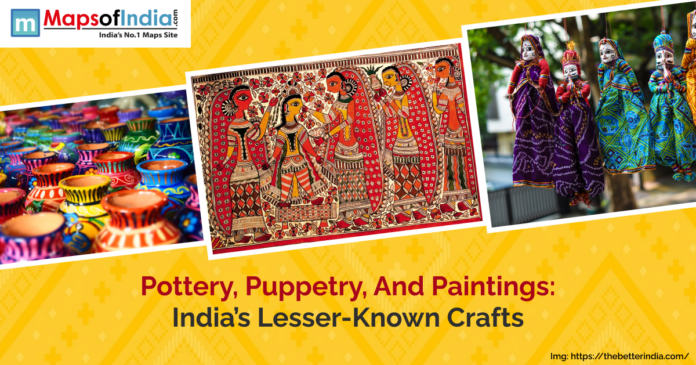Artistic traditions in India are lively examples of the many different cultures spread across the country. Although some traditional arts like Madhubani paintings and Channapatna toys are world-known, many other crafts in the heartlands still sustain stories, customs and identities from the past. We examine examples of pottery, puppetry and paintings, all of which reflect the rich culture of India.
Pottery: Shaping Stories from Clay
Molela Terracotta – Rajasthan
Molela village in Rajasthan’s Rajsamand district is famous for its lovely terracotta plaques. There is a difference, since flat-relief artworks on pottery often show religious figures, traditional tales and на village scenes. Made largely by the Kumhar group, the small pictures are important to rituals performed by Bhil and Garasia tribes, who think the plaques bring fortunes and blessings to their homes.
Andro Pottery – Manipur
Married women in Andro, Manipur, are the sole makers of Charai Taba pottery. In this technique, coil pottery is made by stacking rows of clay, a practice mothers-in-law hand down to their daughters-in-law. Because this work is based on the Sanamahi faith, it produces practical objects and illustrates how the community stands firm in their beliefs when faced with change.
Puppetry: Threads of Tradition
Chadar Badar – Jharkhand and Bengal
Chadar Badar which is traditionally called Santhal puppetry, is an exciting form of tribal theater done by the Santhals of Jharkhand and West Bengal. Performers use wooden puppets and tell stories from Santhal legends in a boxed stage with traditionally tribal music. Thanks to their detailed paint and string control, each puppet tells stories that have been shared orally for a long time.
Tholu Bommalata – Andhra Pradesh
The form of Tholu Bommalata comes from Andhra Pradesh and uses big, translucent leather puppets. These puppets are manipulated using skill by Sutradhars, as they share stories from the Ramayana and Mahabharata. There is a mix of art, music and storytelling in the dance which shows off the region’s cultural background.
Paintings: Canvases of Culture
Nirmal Paintings – Telangana
The small town of Nirmal in Telangana is famous for its unusual paintings marked by gold shades and detailed pictures. In the 14th century such paintings usually featured themes drawn from the Ajanta murals and Mughal artworks. The Naqash artisans use their skill to lacquer wood, sketch on them and apply natural dyes that finish in a varnished artwork of great elegance.
Aipan Art – Uttarakhand
Aipan is considered a ritualistic folk art from Kumaon and usually is practiced by women during important ceremonies. With white paste on brick-red tiles, artists make fine patterns representing good fortune and safety. The designs appear both at entrances, in prayer rooms and in courtyards, for decoration as well as spiritual meanings.
Phad Painting – Rajasthan
This type of painting, Phad, represents stories about the gods and heroes native to Rajasthan on scrolls. Usually several feet tall, these vivid scrolls are held by Bhopas who perform stories for the crowd. With many details, the artworks capture battles, festivals and stories of God’s involvement, making them both religious treasures and useful for passing on stories.
Reviving and Sustaining Traditional Crafts
These forms of art can only survive if supported by communal and official organizations. Events such as workshops and exhibitions created by SCZCC in Nagpur are very important for the promotion of Warli, Gond, Mandana and Cheriyal.
Soumya Singh and Anupriya Sharma are among the women artisans in Prayagraj who have turned traditional crafts into successful lines of natural tie-dye clothing and jute jewelry.
Moreover, special exhibitions such as “Shrijan – The Birth of a Craft” at the National Crafts Museum in New Delhi promote the work of artisans and help them earn a living.
The Road Ahead
With technology and fast city growth, the future of these crafts depends on mixing new ideas with old traditions. Young artists are blending traditional skills with modern designs to keep them fresh and appealing today. Artists’ joint efforts with designers, online stores and tourism efforts have launched new markets, refreshing old customs. Even so, helping out with education, training new skills and fair trade is vital to secure the jobs of India’s cultural traditionalists. When we safeguard the traditions behind these crafts, India’s less popular arts have a better chance of surviving and reaching the future.
Conclusion
These hidden forms of craft aren’t just pretty objects; they show the stories, principles and heritage of India. Supporting and respecting these arts gives our nation’s unique heritage a lasting place and helps communities that keep these ages-old traditions alive. Since we hold this tradition, we need to uphold and honor the many crafts that shape Indian culture.




